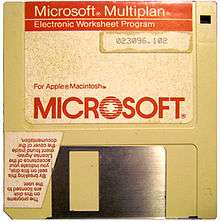Multiplan
Multiplan was an early spreadsheet program developed by Microsoft. Known initially by the code name "EP" (for "Electronic Paper"), it was introduced in 1982 as a competitor for VisiCalc.
 Screenshots of Multiplan on DOS (top) and the Commodore 64 (bottom) | |
| Developer(s) | Doug Klunder[1] of Microsoft[1] |
|---|---|
| Initial release | August 1982[2] |
| Written in | p-code C |
| Operating system | CP/M, Apple II, Macintosh, MS-DOS, Xenix, Commodore 64, CTOS, TI-99/4A, TRS-80, Thomson computers |
| Type | Spreadsheet |
Multiplan was released first for computers running CP/M; it was developed using a Microsoft proprietary p-code C compiler[1] as part of a portability strategy that facilitated ports to systems such as MS-DOS, Xenix, Commodore 64 and 128, Texas Instruments TI-99/4A (on four 6K GROMs and a single 8K ROM), Radio Shack TRS-80 Model II, TRS-80 Model 4, TRS-80 Model 100 (on ROM), Apple II, and Burroughs B20 series. The CP/M version was also runnable on the TRS-80 Model II and 4, Commodore 128, and Apple II with a CP/M card. In France, Multiplan was also released for the Thomson computers in 1986.
Despite the release of Microsoft Chart, a graphics companion program, Multiplan continued to be outsold by Lotus 1-2-3. Multiplan was replaced by Microsoft Excel, which followed some years later on both the Apple Macintosh (1985) and Microsoft Windows (1987).
Although over a million copies were sold, Multiplan was not able to mount an effective challenge to Lotus 1-2-3. According to Bill Gates, this was due to the excessive number of ports (there were approximately 100 different versions of Multiplan). He also believed that it was a mistake to release 8-bit versions instead of focusing on the newer 16-bit machines and as a result, "We decided to let [Lotus] have the character-based DOS market while we would instead focus on the next generation--graphical software on the Macintosh and Windows."
Around 1983, during the development of the first release of Windows, Microsoft had plans to make a Windows version. However the plans changed a year later.
A version was available for the Apple Lisa 2 running Microsoft/SCO Xenix 3. It fit on one 400K microfloppy diskette.[3]
Cell addressing differences
A fundamental difference between Multiplan and its competitors was Microsoft's decision to use R1C1 addressing instead of the A1 addressing introduced by VisiCalc. Although R1C1-style formulae are more straightforward than A1-style formulae[4] – for instance, "RC[-1]" (meaning "current row, previous column") is expressed as "A1" in cell B1, then "A2" in cell B2, etc. – most spreadsheet users prefer the A1 addressing style introduced by VisiCalc.[5][6]
Microsoft carried Multiplan's R1C1 legacy forward into Microsoft Excel, which offers both addressing modes, although A1 is MS Excel's default addressing mode.
Reception
Ahoy! called the Commodore 64 version of Multiplan, distributed by Human Engineered Software, a "professional quality spreadsheet ... There is not enough room in this article to mention all the mathematical operations performed ... Documentation is lengthy but well written".[7] A second review in the magazine noted the limitation of the computer's 40-column screen, but praised the ability to stop any ongoing action. It also praised the documentation, and concluded that "its ease of use and foolproof design make Multiplan an outstanding value".[8] BYTE said that "Multiplan for the Macintosh is a winner", stating that combining other versions' power and features with the Macintosh's graphics and user interface "rivals, and in many ways exceeds, anything else available in the spreadsheet genre".[9]
See also
References
- Microsoft: The Early Days from the personal website of Richard Brodie
- Laurie Flynn; Rachel Parker (August 7, 1989). "Extending Its Reach". InfoWorld. 11 (32): 45. ISSN 0199-6649. Retrieved June 1, 2020.
- Photograph of Lisa Xenix Multiplan diskette (JPEG) (Digital photography). Postimg.com. Retrieved 2018-01-01.
- VBA and Macros for Microsoft Excel by Bill Jelen & Tracy Syrstad, Chapter 6
- Fundamentals of Crime Mapping: Principles and Practice by Rebecca Paynich and Bryan Hill
- Excel VBA 24-Hour Trainer by Tom Urtis
- Silveria, Terry (May 1984). "Spreadsheets for the C-64". Ahoy!. p. 18. Retrieved 27 June 2014.
- Addams, Shay (June 1984). "Multiplan". Ahoy!. pp. 55–56. Retrieved 27 June 2014.
- Trachtenberg, Mitch (December 1984). "Multiplan/Chart on the Macintosh". BYTE. pp. A85–A93.
